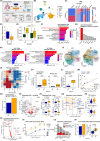Single-cell multi-omics reveals tumor microenvironment factors underlying poor immunotherapy responses in ALK-positive lung cancer
- PMID: 39754710
- PMCID: PMC11999889
- DOI: 10.1002/cac2.12658
Single-cell multi-omics reveals tumor microenvironment factors underlying poor immunotherapy responses in ALK-positive lung cancer
Conflict of interest statement
The authors declare that they have no conflicts of interest.
Figures

References
Grants and funding
LinkOut - more resources
Full Text Sources
Molecular Biology Databases

